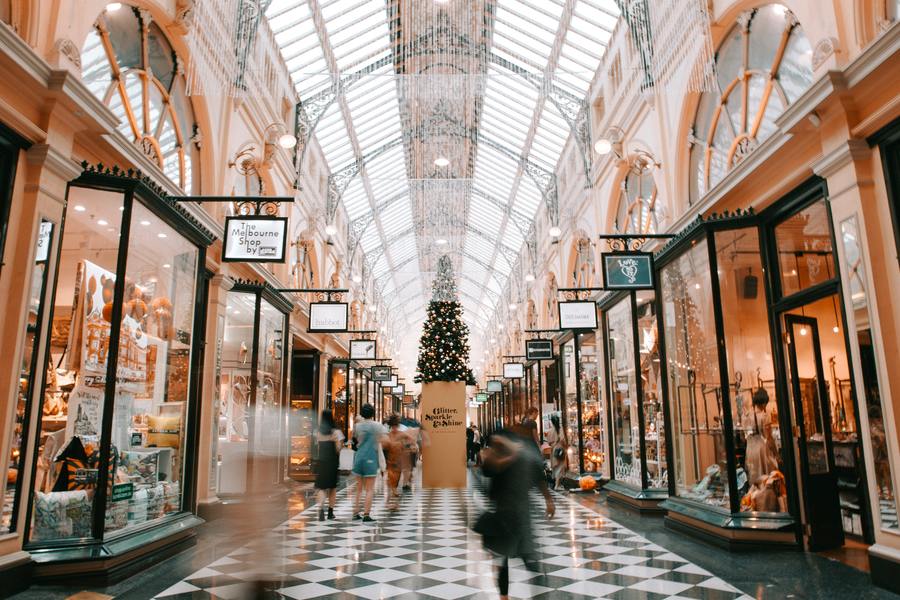How do shopping centres generate high levels of footfall?

In this article, we are going to show you all the various factors that go into creating a busy and profitable shopping centre. We will also explain why and how you can tap into these lucrative locations as a brand.
Location
When it comes to sectors that rely heavily on footfall, location is everything.
Successful shopping centres are usually located in areas that already see a high level of footfall. This may be bustling shopping streets, near busy train stations or other busy locations.
Although some shopping centres may be located away from the centre of cities and towns, in these cases they tend to take advantage of busy roads, making it easy for people to access them and therefore benefiting from increased footfall.
As eCommerce becomes increasingly competitive to physical retail, location and convenience will become an ever more important factor in shopping centre success.
Transportation
Transport links also play an important role in generating high levels of shopping centre footfall. In the last section, we mentioned how many shopping centres will take advantage of main transport routes such as busy roads or train stations by picking a location near them.
Some larger shopping centres will invest in improving transport links in order to generate more footfall. This can include anything from creating their own roads, locating marge car parks on-site or even funding their own bus routes.
Mixed-Usage
Getting the right location and transport links is all about making sure that a shopping centre is accessible. Another key part of the equation for shopping centre success is ensuring that it is also desirable to visit. After all, it doesn’t matter how easy it is to get somewhere if customers don’t feel compelled to go there.
This is where mixed usage comes in. By offering a range of experiences and services, shopping centres can bring in huge numbers of people. Again, this helps them to increase the convenience of their location, allowing people to tick off multiple purposes in one visit.
For example, alongside retail stores you may also find the following locations at shopping centres:
- Libraries
- Gyms
- Exhibition spaces
- Cafes
- Restaurants
- Cinemas
- Child care centres
- Events
- Pick up locations (such as Amazon Lockers)
By introducing locations that customers have to physically visit, it also encourages them to use services that they may otherwise be able to get online - such as the majority of retail products.
The combination of retail, entertainment and food and drink establishments also creates a location where people can travel to spend a substantial amount of time and enjoy the experience, making it all the more appealing as a destination.
This wide appeal means that shopping centres can become central locations for wider communities and groups. In fact, some centres take their cultural significance even further by offering functional spaces such as parks and even nondenominational chapels, as well as hosting events such as locally celebrated festivals and holidays.
Pop-up Shops
Shopping centres need to walk the fine line between providing customers with what they expect, such as the big-name retailers, restaurants and entertainment chains and offering new and exciting experiences.
This is where pop-up shops come in.
Pop-ups offer shopping centres both a way to attract new customers through the door and a way to engage current customers and offer them new and exciting experiences. By using pop-ups, shopping centres can also gauge interest in new exciting brands, products or concepts, giving them a good idea of what might work as a permanent fixture in the future.
Technology & Marketing
New technologies are also helping shopping centres to increase footfall and further engage their customers.
For example, some shopping centres have invested in technology that allows them to send push notifications to phones as they enter or walk near their premises. This is especially beneficial in areas with high footfall, such as shopping centres located on busy shopping streets as it is a quick and easy way to push instore events or special offers to entice customers through the door.
We also see a trend for creative and cutting edge displays being used by shopping centres in order to grab the attention of passing customers. These are often done in collaboration with leading brands. One good example of this is Chanel’s takeover of the Harrods entrance during the Christmas season, using their recognisable perfume bottle shape to draw attention and entice people inside.
Leveraging Shopping Center Footfall
In this article, we have explored some of the ways that shopping centres build high levels of footfall. But how can this benefit brands?
Pop-up shops can be a smart and lucrative way for brands to tap into the attention and customer engagement that shopping centres work hard to achieve.
When you run a pop-up shop in a shopping centre you can tap into many benefits. These include:
- Being able to sell to the shopping centres ready-made audience
- Benefiting from a well-established infrastructure
- Tapping into the buzz created by substantial marketing campaigns surrounding the shopping centre
- Becoming closely associated with the shopping centre itself and the various brands that are located there
- Allowing you to test a product/service/concept/brand without a hefty investment in a permanent store
Shopping Centres: Targetting Customers
It is clear that shopping centres invest a lot of time, money and planning into driving high levels of footfall through the door. It is also clear that brands can tap into this footfall with low levels of investment by hosting pop-up shops.